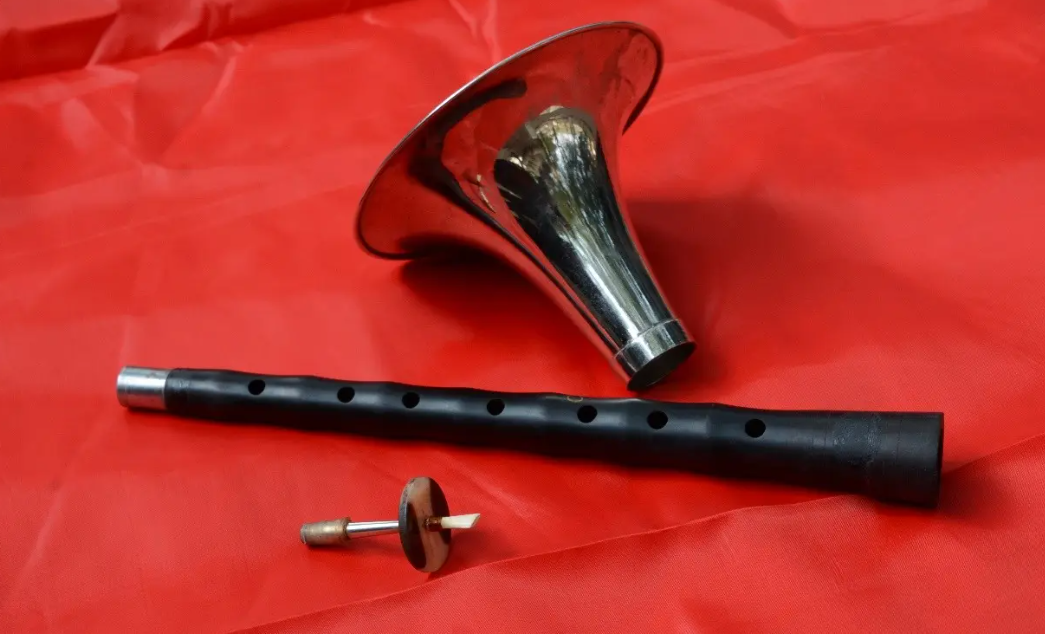Suona in the Children's Palace
On the afternoon of June 9, when school was over, the reporter walked into the Children's Palace of the Central School of Lingshan Town, Meilan District, Haikou City, and heard bursts of cheerful and bright suona sounds. A child in a school uniform is practicing suona in a music classroom.
"My name is Zhang Yongcheng, and I'm in fifth grade this year." Seeing the reporter approaching, he took the initiative to introduce himself, "I play suona, which belongs to the 'flute' in the octave."
"Can you play a song?" the reporter asked with a smile. Zhang Yongcheng immediately adjusted his posture, puffed up his cheeks and played, his small eyes were round, and his fingers jumped flexibly on the suona hole.
Zhang Yongcheng's love for octaves and suona seems to be innate, and he doesn't quite understand the reason, but he never wants to let it go after learning.
He is 9 years old this year, and his first contact with Ba Yin was 3 years ago. At that time, the school was setting up an octave class, and his parents decided to let the lively and active Zhang Yongcheng try it out. The teacher saw that he was strong and had flexible fingers, so he was assigned to the octave suona group.
The first time I met Ba Yin, I saw the suona for the first time. Although it was not a rhythm, it made Zhang Yongcheng’s heart surge. "The octave as a whole sounds very classical, and the sound of the suona is very festive and loud."

Strings, pianos, flutes, pipes, flutes, gongs, drums, and cymbals are the eight major types of musical instruments that make up the Hainan octave.
Eight-tone is a national intangible cultural heritage and an important local art variety in Hainan, which has been handed down for thousands of years. In the Qiongbei area, it is a traditional folk custom to invite the Eight Music Team to perform on major festivals.
Zhang Yongcheng also knows the meaning of inheriting the art of octave. "The teacher told us that octave is a very ancient art. If no one learns it, it will be lost."
From the first day of joining the octave class, Zhang Yongcheng has been learning suona without a single lesson. He is in the school's Children's Palace every week, studying with professional teachers from the Provincial Musicians Association, and playing with his classmates. In 3 years, he can only play one kind of voice, to can play single syllable, glissando, vibrato, and can solo "Daffodils" and "Send Jing Niang" and other classics.
When he first learned to play suona, Zhang Yongcheng's cheeks were often sore, making it difficult for him to eat and speak. Parents feel distressed about their child and ask him, "Do you want to continue studying?". Zhang Yongcheng replied: "The octave class is the same as the Chinese class and the math class. You can't miss it. Our class is an octave class, and you can't miss any of the sounds."
There are 55 children in Zhang Yongcheng's octave class. They are divided into 8 study groups according to the type of musical instruments they play. They usually study in groups and play together during performances. "Gathering is a ball of fire, and scattered is a sky full of stars." Huang Yuming, a student of pipa playing in the octave class, made an ingenious analogy, she said, "I like the sound of the pipa playing solo, and when the pipa is integrated into the octave, The momentum of the eight types of musical instruments playing together.”
As soon as the eight-tone sounded, the momentum was self-generated. As Huang Yuming said, almost everyone who has heard the Hainan octave will be touched by the melodious and unrestrained tunes and high-pitched music of the octave. Huang Yuming and Zhang Yongcheng liked the feeling of playing octaves every time they stood on the stage. The music started, the ensemble ended, the tune ended, the curtain call was made, the bowing, the applause in their ears, and their hearts were also filled with pride because of the eight tones. "I am proud of myself and proud of our traditional art," said Huang Yuming.
In recent years, the eight-tone characteristic education of Lingshan Town Central School has become well-known. Many schools send people to visit and study, and many media reporters go to interview and report. When Zhang Yongcheng was playing, many visitors asked what it was. He always said with a smile and pride, "This is the octave, which is an intangible cultural heritage of Hainan."
 渝公网安备 50010702504639号
渝公网安备 50010702504639号